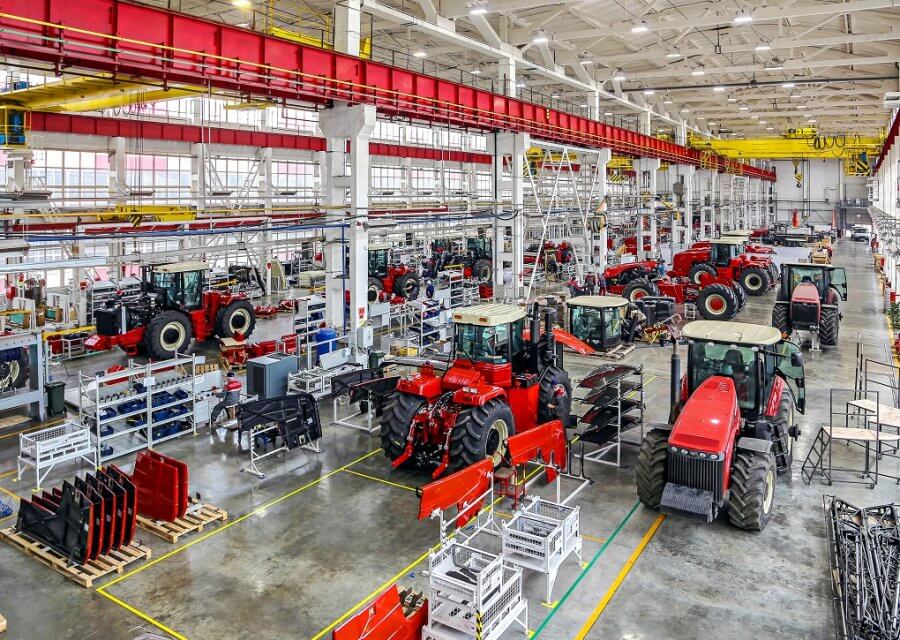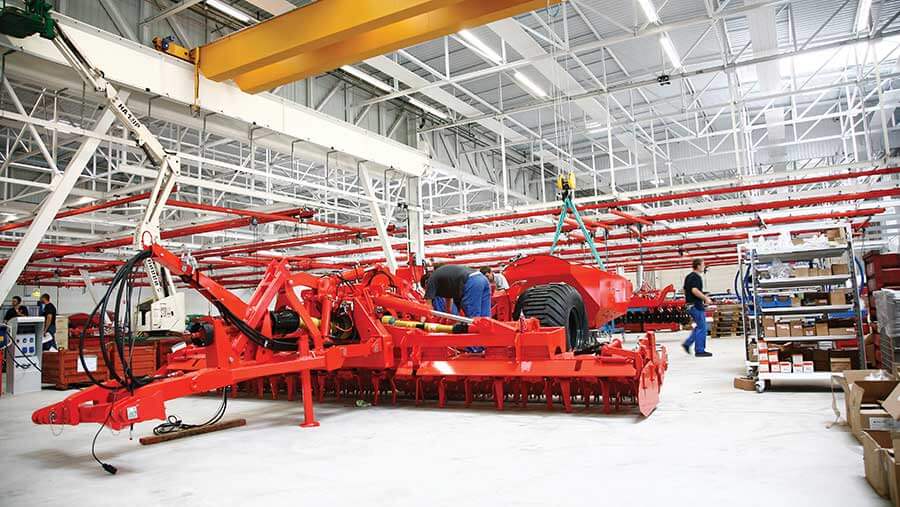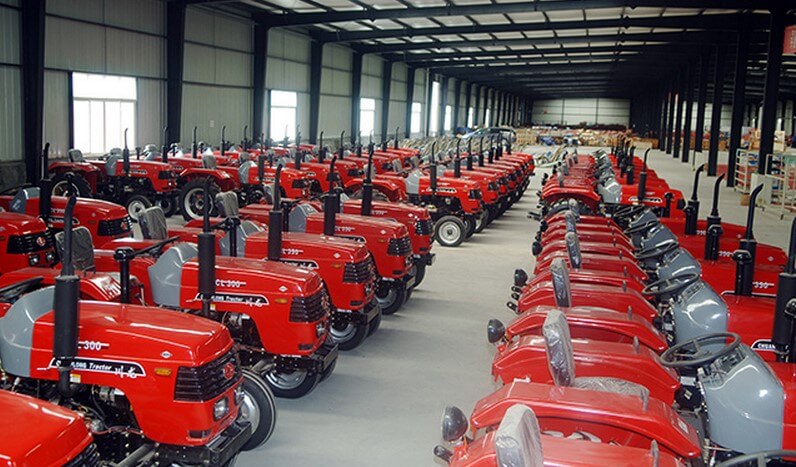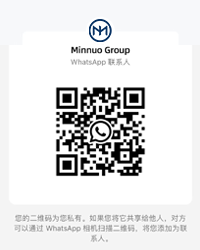In a climate of rising prices and unstable supply chains, more and more buyers are turning their attention to Chinese-made agricultural machinery. Not only does Chinese agricultural machinery have the advantage of being reasonably priced and available in a wide range of products, but it has also become an important source for international farmers and distributors looking for cost-effective equipment due to its mature manufacturing system and extensive export experience. Especially for small and medium-sized buyers, sourcing farm machinery from China is no longer a “low-cost alternative”, but a “mainstream choice”.
So why all the focus on “how to safely import farm machinery from China”? The reason is that agricultural equipment is not a one-time transaction, but a critical investment involving long-term use, maintenance and operating costs. If you make a mistake in choosing a supplier, you may face serious consequences such as customs clearance failure, after-sales disconnect and failure to repair. Compared with “low price”, a truly reliable equipment supplier should have compliance certification, delivery capability and after-sales guarantee.
This article will disassemble the whole process of safely importing Chinese agricultural machinery for you one by one, from choosing reliable suppliers to avoiding common risks, and through practical advice and real cases, help you to be “well-informed and worry-free” from the first time of purchasing. Whether you are a farmer, a dealer or a cross-border procurement manager, this is a practical guide you can’t miss.
Contents
- 1 Ⅰ.Why Buy Agricultural Machinery from China?
- 2 Ⅱ.Key Concerns When Importing Agricultural Machinery
- 2.1 1. Difficulty in quality control (fear of poor quality and short service life)
- 2.2 2. Risk of fraudulent suppliers (false information, fraudulent orders)
- 2.3 3. Language communication barriers (technical parameters, configuration understanding deviation)
- 2.4 4. Lack of after-sales and technical support
- 2.5 5. Maritime transportation risks and delays
- 2.6 6. Customs clearance and certification do not meet the requirements of the destination country
- 3 Ⅲ.Step-by-Step Guide to Importing Safely
- 3.1 ✅ Step 1: Identify the Right Supplier | Pick the right reliable supplier
- 3.2 ✅ Step 2: Confirm Specifications & Customization | Confirm Equipment Parameters & Optional Configurations
- 3.3 ✅ Step 3: Secure the Deal with a Clear Contract | Sign a clear contract to ensure the rights and interests
- 3.4 ✅ Step 4: Factory Inspection & Quality Control | Shipments Inspection & Quality Control | Quality Inspection & Inspection before shipment
- 3.5 ✅ Step 5: Logistics & Customs Clearance | Logistics Filing and Customs Clearance Suggestions
- 4 Ⅳ.After-sales Service & Maintenance Support
- 5 Ⅴ.Case Study: A Successful Import from China
- 6 Ⅵ.Tips to Avoid Import Risks
- 6.1 ❗1. Avoid choosing suppliers that “offer too low a price”
- 6.2 ✅ 2. Priority should be given to manufacturers with physical factories (not pure traders)
- 6.3 3. Understand the regulations and import standards of the destination country in advance
- 6.4 4. Keep communication records and build a “chain of evidence” to prevent disputes
- 7 Conclusion
Ⅰ.Why Buy Agricultural Machinery from China?
As global agricultural machinery prices rise and cross-border sourcing channels become more and more diversified, more and more agricultural users are paying attention to Made in China. China’s agricultural machinery is not only price competitive, but also has formed a complete advantage in product variety, technological innovation, export services, etc. The following are the three core reasons:
1. Comparative advantages of Made-in-China: low cost, large production capacity, and rich experience in export
China has formed a strong industrial cluster effect in agricultural machinery manufacturing:
Significant cost advantage: the overall low cost of raw materials, labor, and ancillary components makes the whole machine Significant cost advantage: the overall low cost of raw materials, labor and ancillary components makes the machine price only 60-70% of European and American brands.
Stable supply due to large-scale production: from tractors to harvesters, seeders and sprayers, there is a complete production chain and large-volume manufacturing capacity.
Rich export experience: brands such as MINNUO, YTO and Zoomlion have many years of experience in the international market, and understand the international standards, certification process and export logistics, which makes the transaction more standardized and after-sales service more efficient.
2. Diversified product categories and intelligent technological innovation
China’s agricultural machinery is not only “many”, but also “new”:
Complete product series: covering entry-level equipment for small farmers, as well as highly-matched intelligent equipment for large-scale planting bases.
Continuous upgrading of technology: more and more products begin to support RTK precise navigation, remote fault diagnosis, automatic path planning and other intelligent functions.
Modularized design: the mainframe and implements can be flexibly combined to meet the actual needs of different terrains and crop types.
This trend makes Chinese agricultural machinery not only a “price-friendly choice”, but also a “technologically balanced choice”.
3. Policy Support + Convenient Foreign Trade Channel, Higher Purchasing Efficiency
National Policy Encouragement for Export: Agricultural machinery enterprises generally enjoy the policy dividends of export tax rebate, credit insurance support, and export financing convenience.
Smooth foreign trade channels: no matter through FOB, CIF or DDP terms, Chinese exporters are highly familiar with cross-border logistics, customs clearance and other processes, and can quickly cooperate with buyers to complete the whole set of processes.
Language and platform support: Most export-oriented agricultural machinery brands have multilingual sales websites and service support (e.g. English, French, Spanish, etc.), which reduces the communication threshold and improves the purchasing experience.

Ⅱ.Key Concerns When Importing Agricultural Machinery
Although cross-border procurement of agricultural machinery can save costs, many overseas farmers face many challenges and risks in practice. Here are the six most common pain points:
1. Difficulty in quality control (fear of poor quality and short service life)
Many buyers are worried that the performance of the actual machines is not up to the standard even though the pictures look beautiful.
Some of the equipment is only “show samples” or ‘inventory’, not after a complete test;
accessories are not standardized, high replacement rate of wearing parts, resulting in a shortened service life;
users actually receive the equipment and found that “less stable than advertised”, but at this point, the defendant is not as stable as it should be. Users actually receive the equipment and find that it is “not as stable as advertised”, but it is difficult to protect their rights at this time.
Suggestion: Priority should be given to regular brands (e.g. MINNUO) that have export experience, have many cases of real photos taken by users, and can provide prototype testing or third-party inspection reports.
2. Risk of fraudulent suppliers (false information, fraudulent orders)
Asymmetric information in cross-border transactions, some “black suppliers” without business licenses or fake stores are frequently found:
fictitious brand background, misappropriation of other people’s graphics, misleading buyers to order;
pulling the plug after receiving the payment, or shipments that are seriously inconsistent with samples;
intermediary subcontracting, the customer is unable to contact the manufacturer directly.
Solution: Make sure to order through the brand’s official website or platform authentication channels, verify the business license, legal identity, proof of authorization.
3. Language communication barriers (technical parameters, configuration understanding deviation)
Agricultural machinery products often involve a large number of parameters (such as horsepower, row spacing, hook-up mode, power distribution mode, etc.), a slight deviation in language expression will lead to:
buying the wrong model: insufficient horsepower / not matched with the farm equipment;
not in the habit of use: do not understand the control interface, the use of the instructions are not clear;
misunderstanding of the functional configuration: thought that it comes with a GPS, but in fact, it is only a reserved interface.
Suggestion: choose a team that supports multi-language communication and pre-sales selection guidance (e.g. MINNUO, which supports English/French/Spanish).
4. Lack of after-sales and technical support
Some suppliers “evaporate” once they ship the products, and cannot provide warranty, spare parts or remote maintenance support;
There is no after-sales process, so users can only figure out how to repair the products on their own once they break down;
Long operation and maintenance cycle and incomplete information lead to small problems becoming big problems.
Suggestion: Prefer brands that can provide initial response within 48~72 hours, remote video guidance and local maintenance network.
5. Maritime transportation risks and delays
Tight container scheduling and complicated customs clearance at destination ports often lead to delays of 1~2 months;
Buyers fail to plan for stock preparation and miss the window of time for plowing/harvesting;
Sometimes the terms of trade provided by the suppliers are unclear, which leads to unclear transportation responsibilities.
Suggestion: Confirm the delivery cycle and transportation terms (e.g. FOB, CIF, DDP) before purchasing, and coordinate with the agent at the destination port.
6. Customs clearance and certification do not meet the requirements of the destination country
Some equipment lacks CE, ISO, EPA, SASO and other certificates, so it can not be imported or used;
Documents are not complete (such as packing list, CO, invoice), resulting in customs clearance deduction or delays;
Some countries have special emission standards, voltage and frequency requirements, so the equipment does not meet the requirements and can not be put into production.
Suggestion: Clarify the relevant regulations of the purchasing country, and prefer Chinese agricultural machinery brands that can provide complete customs declaration information and international certificates.
Ⅲ.Step-by-Step Guide to Importing Safely
When purchasing agricultural machinery across borders, it is important to look at price and performance, but also to avoid risk and protect delivery. Especially for first-time buyers of agricultural equipment from China, it is important to understand “how to place an order safely”. Here are five steps to help you make a rational choice and purchase with confidence.
✅ Step 1: Identify the Right Supplier | Pick the right reliable supplier
Choose the platform to be formal, recommended:
Alibaba, Made-in-China, the brand’s official website directly
Beware of the “three no’s” sellers: no official website, no business license, no export records
Verification Reference points:
Business license, customs import and export registration certificate (such as customs number)
International certification qualifications: CE, ISO9001, EPA, SASO, etc.
Look at the number of cases, whether there is a video demonstration, whether the overseas customers are widely distributed
Key Tips:
Priority is given to the agricultural machinery brands that have a stable record of exports and a long-term customer base, such as MINNUO (Minnuo), Zoomlion, etc. Zoomlion is the most important brand in the world, Zoomlion, Zoomlion, etc.
✅ Step 2: Confirm Specifications & Customization | Confirm Equipment Parameters & Optional Configurations
Different countries and farms have different requirements for the equipment, so you should confirm in detail:
Matching of application parameters: such as horsepower band, wheelbase, transmission mode, and suitable terrain.
Crop Suitability: Is it suitable for corn, wheat, vegetables, orchards, etc.
Functionality Expandability: Does it reserve RTK interface? Does it support modification or connection of agricultural tools?
Suggestions for communicating with suppliers:
Require technical manuals, product configuration lists, accessory lists, function demonstration videos
Photos of sample machines are not equal to parameter matches, make sure to check whether they can meet local agronomic needs
✅ Step 3: Secure the Deal with a Clear Contract | Sign a clear contract to ensure the rights and interests
The cross-border dealings must be implemented in the contract, to avoid disputes. The contract should include:
Model, specification and quantity of the equipment
Packing method, place of origin, warranty commitment
Payment method (e.g. 30% in advance, 70% before shipment), delivery time
After-sales service, spare parts supply cycle
Reminders:
We recommend using Chinese and English in the text of the contract
Whether the counterparty is willing to sign the contract with a seal or not is an important basis for judging the degree of formality
✅ Step 4: Factory Inspection & Quality Control | Shipments Inspection & Quality Control | Quality Inspection & Inspection before shipment
Before shipment from the factory, quality inspection must be arranged to ensure that the factory products are consistent with the agreement.
Common ways include:
Support third-party organizations to inspect the goods: such as SGS, TÜV, Intertek
Take shipping video or inspection video: to confirm that the parts and components are complete, the appearance is intact, and the coding is consistent
Provide the test report or function verification video
This is the key line of defense to ensure that “what you receive is genuine and can be used normally”.
✅ Step 5: Logistics & Customs Clearance | Logistics Filing and Customs Clearance Suggestions
Transportation and customs clearance should not be ignored, otherwise it will lead to delays or even detained goods:
Operation Suggestions:
Choose an experienced logistics company or the brand’s own freight forwarder
Define the trade terminology in advance (FOB, CIF, DDP)
Verify the certification requirements of the destination country (such as EPA, CE, SASO), SASO)
Preparation of Customs Clearance Documents:
Invoice, packing list, bill of lading, certificate of origin (CO)
If subsidies or tariff exemption policies are involved, you should coordinate with the seller to prepare the information in advance.
“Safe Order” is not just about choosing a machine, but also a systematic decision-making process. It is a systematic decision-making process. Every detail may affect the delivery result and the experience of using the machine.

Ⅳ.After-sales Service & Maintenance Support
Cross-border procurement of agricultural machinery is not a “one-shot deal”, and in the process of long-term use, you may encounter problems such as replacement of parts and components, questions about use, and system maintenance. Therefore, whether the supplier can provide timely, professional and traceable after-sales service is a key factor to determine whether it is reliable.
① How to judge whether the manufacturer’s after-sales service is reliable?
Focus on the following three points:
✅ Whether they can provide remote video guidance (e.g. Zoom, Skype, WhatsApp)
✅ They can promise in advance the response period and protection mode of key parts (e.g. free under warranty/out-of-warranty discount)
✅ Whether they have stationed technicians or a local maintenance support network
For example, MINNUO provides Zoom video troubleshooting service with a complete service process and parts allocation mechanism, 48 hours for common parts, and a complete service process and parts allocation mechanism.
② recommended to sign a parts supply agreement
after-sales service is not a verbal commitment, should be clear in the contract terms related to the supply of parts:
standard list of spare parts and number (to facilitate the procurement of docking)
fast parts, wearing parts of the supply cycle (whether there is a stock inventory)
non-standard parts / customized parts of the production time and cost description
fault response and after-sales process (such as application, review, delivery time limit)
It is recommended to ask the manufacturer to provide the “Commitment for Spare Parts Supply” or an additional agreement containing this content to ensure the efficiency of maintenance in the later stage.
③ Obtain English User Manuals and Maintenance Guides
A clear manual = the first safeguard to reduce the risk of use.
Make sure that the manufacturer can provide:
English operation manual (or bilingual version)
Recommended table of daily maintenance cycle
Troubleshooting and simple troubleshooting instructions
Equipment parts location diagram, disassembly and installation guide
Tip:
Many brands (such as MINNUO) also have electronic video tutorials to support “learning by watching”, especially suitable for the training of skilled workers or users who have first contact with the model.
Does it support remote training and technical guidance?
A truly responsible brand will not just sell the equipment, but will accompany the customer to use the equipment well.
It is recommended to give priority to:
Manufacturers that provide Zoom/WhatsApp video technical support
Can guide users to solve problems in real time through video demonstration
Regularly arranges “training on installation and use of the new machine” or “online operation Q&A”
For example: MINNUO supports Zoom video docking in after-sales service.

Ⅴ.Case Study: A Successful Import from China
Case Reference: Successful Agricultural Machinery Import Project
This case shows the whole process of an African farmer sourcing agricultural machinery through a Chinese supplier, reflecting the key role of “clear requirements + stable supply + visualized delivery + smooth customs clearance” for successful cross-border sourcing.
Customer Background
A is a medium-sized farmer from East Africa, mainly engaged in corn and soybean crop rotation, with a farm area of about 100 acres. Due to the lack of local agricultural machinery, he decided to try to import Chinese agricultural machinery to improve operational efficiency.
Purchased equipment
A medium horsepower 4×4 tractor (with hydraulic output interface)
A heavy-duty rotary tiller (which can be directly mounted on this model of tractor)
The combination was chosen to: improve soil tilling efficiency, and adapt to the pre-sowing preparation of multiple types of crops.
Key Success Points
1. Clarify Communication Needs (Demand Precision)
The following was communicated in detail with the Chinese supplier via Zoom video conferencing:
Topography and soil type of the plot
Required tillage width and horsepower range
Interface specifications and compatibility of the supporting implements
English language requirements of the user and subsequent maintenance operability
Based on the information, the supplier recommended a tractor + rotary tiller combination with a high degree of suitability, avoiding the problem of “buying a tractor that can’t be hooked up to a rotary tiller,”
2. Visualization of shipment (operation transparency)
The supplier improves buyers’ trust by:
Providing video of the whole machine operation before shipment and the actual machine demonstration screen
The photos of assembly details are attached before shipment to ensure that the user can dock correctly
Providing video of packing to show the real shipment and the integrity of the parts
3. Clarity of the export process (smooth customs clearance)
Providing the complete export documents: invoices, packing lists, certificates of origin, and photos of the shipment
According to the According to the customs requirement of buyer’s importing country (Kenya), we prepared the EPA certification copy in advance
The export adopts DDP terms (including customs clearance and tariffs), and the logistics and customs clearance are unified by the cooperative forwarder.
✅ Feedback from customers
“The whole transportation of the equipment can be tracked, and the video of the installation is easy to understand, and the tractor is powerful and stable after it starts to run and there is no abnormality in using it in the past season. WhatsApp reply quickly, within 48 hours to get the required spare cartridge, the procurement experience exceeded expectations.”
Case Insights:
Detailed communication is a prerequisite for successful cross-border agricultural machinery procurement;
Visualized delivery greatly reduces procurement uncertainty;
Selecting brands with export experience and service mechanisms (such as MINNUO) is more trustworthy.
Ⅵ.Tips to Avoid Import Risks
In the process of cross-border procurement of agricultural machinery, risks are often hidden in the “invisible details”. In order to prevent stepping into the pit and avoid losses, it is important to make the following four preparations in advance:
❗1. Avoid choosing suppliers that “offer too low a price”
Too low a price often implies hidden risks:
equipment for the clearance of the last goods or discontinued old models, it is difficult to find spare parts;
lack of standard certificates, the existence of a hidden risk of not being able to clear customs;
Maliciously low prices and then shipped through the “reduced configuration”, such as insufficient horsepower, accessories deleted;
production process is backward, unstable quality, high failure rate.
✅ Suggestion: Choose the supplier with “reasonable” price instead of “low price”, and refer to the quotation range of peers and the average price of the market.
✅ 2. Priority should be given to manufacturers with physical factories (not pure traders)
Manufacturers with factories usually have the following advantages:
Better understanding of the product structure and process, and can be customized according to the needs;
Provide on-site video, demo drawings, production process traceability;
Easier to arrange for after-sales docking (spare parts, maintenance, operational guidance);
High contract stability, more controllable shipment cycle.
In contrast, some “shell traders” without factories may only be intermediate subcontracting, it is difficult to guarantee the source of goods and services.
3. Understand the regulations and import standards of the destination country in advance
Different countries have different standards for agricultural equipment, especially:
whether CE, EPA, SASO and other certificates are required;
it is mandatory to use environmentally friendly engines, low-noise technology, etc.;
whether it is required to have a local test report or registration declaration.
✅ Suggestion: Before placing an order, confirm with the supplier whether the equipment meets the technical requirements of the importing country and ask them to provide the necessary documents.
4. Keep communication records and build a “chain of evidence” to prevent disputes
Cross-border purchasing is a long chain of transactions, and it is necessary to do the following:
Confirm all quotations, configuration parameters, and terms and conditions of the agreement by email or written records;
Use formal quotations (with company letterhead and signatures) rather than screenshots or verbal promises;
Clearly set out in the contract or chat records: “Payment method, delivery period, after-sales service”.
In case of dispute or tax refund or insurance claim, the complete record will be a strong evidence support.
✅ Summary of practical suggestions:
Risk types Suggested ways to prevent
Quotation is unusually cheap Be cautious, check for specification shrinkage or non-certified models
No actual factory support Priority is given to choosing manufacturers that can provide factory certification and field video
Technical standards are not clear Take the initiative to ask the supplier whether it is in line with the regulations of the destination country and ask for certificates
Communication is not documented Uniformly confirm the content of the contract by email, and form documents to save the important matters
As long as you follow the above four principles, together with the previous five judgment indicators, you can significantly reduce the risk of importing Chinese agricultural machinery
Conclusion
The key to realizing “safe importation of Chinese agricultural machinery” does not lie in low prices, but in “choosing the right supplier + strict control of process details + clear after-sales protection”.
Agricultural machinery procurement is not only about equipment performance, but also about long-term operational stability and business returns. Cross-border procurement, in particular, is more likely to be subject to “invisible risks”: false suppliers, customs clearance barriers, lack of after-sales service and other issues are endless. This article breaks down the eight key steps from choosing suppliers, confirming configurations, signing contracts, to factory inspection, logistics clearance, after-sales maintenance, and so on, to help purchasers establish a systematic judgment ability.
For first-time importers, it is highly recommended to use “small batch trial order” as an entry point to build up cooperation trust step by step. Chinese brands that are really worth long-term cooperation not only provide machines and equipment, but also have the ability to deliver the whole process, export experience and problem response mechanism.
MINNUO, as a Chinese agricultural machinery brand with rich experience in exporting, has a complete integrated solution of “whole machine+tools+systems”, which can support personalized customization, English data output and remote technical training. Its products have been exported to Africa, Southeast Asia, South America and other places, with stable operation and timely service, won a large number of farmers and dealers highly evaluated. If you are looking for a Chinese agricultural machinery partner that is “hassle-free, practical and well-supported”, you may want to start a more reliable cross-border purchasing journey from minnuoagro.com.

